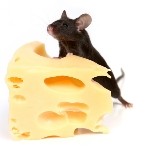Courage in Being the Second Mouse
 I read a funny quote the other day, actually a list of Paraprosdokians that my friend Hal Korff sent. (Thanks, Hal.) It goes like this:
I read a funny quote the other day, actually a list of Paraprosdokians that my friend Hal Korff sent. (Thanks, Hal.) It goes like this:
“The early bird may get the worm, but the second mouse gets the cheese.”
It’s a funny line, but I got to thinking about the subject of courage, a topic that has been on my mind lately. After finishing our book The Influencing Formula, I find myself spotting examples of the formula, or parts of it, namely [trust + preparation * courage]. It’s not a mathematical formula, for sure, so please don’t try and do any algebra with it!
Instead, the formula reminds us we need all three components to be influential in our jobs, whatever they may be. My partner Elizabeth and I focus on business analysis and project management training, so we see influencing opportunities on projects. A classic example is when we are asked to implement a project which might be “jumping to a solution,” we can work to influence business leaders to do a business case. Or, we can make sure all the root causes of the current situation and current-state requirements are understood, so the solution is configured appropriately.
But, how do we go about doing that? If we appear to be roadblocks, our colleagues and stakeholders might not think we are “team players” and our careers could be threatened. Our answer to that is you need the trust of the people you are trying to influence, and also to do your background work to understand the current situation and context thoroughly. But, it doesn’t end there. We won’t be influential without showing the courage to make your proposal.
That brings me back to the mouse and the cheese. Courage is not jumping out in front of oncoming arrows like Braveheart. It is more like the character Lionel Logue in the movie The King’s Speech. (Did you notice I like movies?) He is a great movie example of courage in action, and if you haven’t seen it you should. It’s one of Elizabeth’s and my all-time favorites.
Logue was courageous in real life with King George VI of England, who had a speech impediment. Without going into too much detail, Logue, a commoner, showed tremendous courage with the King and helped him control his stuttering enough to deliver the most important speech of his life.
Logue wasn’t the first therapist who tried to help the King, and who knows what would have happened if he had been. After trying and failing with many other therapists, the King slowly became receptive to Logue’s methods. It wasn’t easy, though, and if you have seen the movie you know it also took much preparation and trust-building to succeed.
The point I’m trying to make is this: be aware of the context in which you are trying to be influential, and how many other “mice” have tried and failed to get the “cheese.” Sometimes it is best to bide your time, building trust and credibility, and save your courage for those situations when the “influencees” are more receptive. By being the second mouse, you will more often succeed in getting the cheese and being influential.
Richard Larson, PMP, CBAP, PMI-PBA, was the founder of and is now a consultant for Watermark Learning. He is a successful entrepreneur with over 35 years of experience in product development, business analysis, project management, training, and consulting. As an internal entrepreneur, Rich led the development of several Watermark Learning online products as a business analyst and product owner.
Rich is a frequent speaker at Business Analysis and Project Management national conferences and IIBA® and PMI® chapters around the world. He has contributed as a lead author to the BA Body of Knowledge version 2.0 and 3.0 and was a lead author on PMI’s Business Analysis Practice Guide. He and his wife Elizabeth Larson have co-authored five books on business analysis.

I think the point of this expression is that the first mouse tries to get the cheese from the trap and is killed. The second mouse can then get the cheese if he is a.) smart enough to recognize the the trap has been sprung and b.) courageous enough to attempt the same task that just got his compatriot killed. You can often accomplish a task that someone else failed at if you recognize why they failed and devise a plan to circumvent the source of failure. After that you need the courage to take on a “failed task”.
John, you are quite right. The proverbial “first mouse” is meant to convey someone who may be rash or hasn’t done enough preparation to see the traps waiting. Or as you say, devise plans to avoid them. You are also correct about needing courage to take on a “failed task.” Thanks for weighing in!